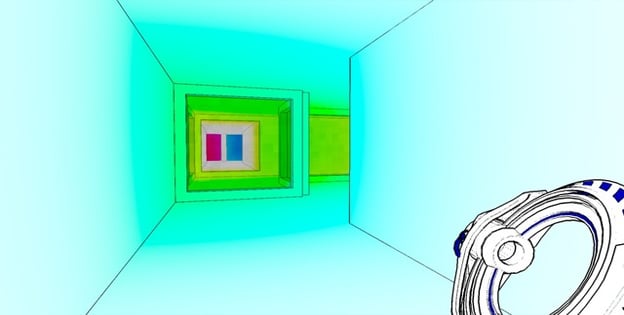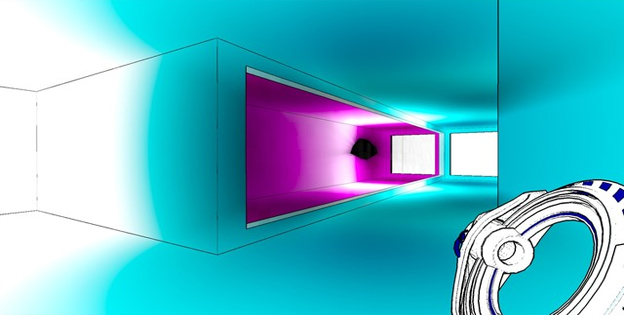A Metaphor For Life, The Universe, And Everything
Open up my head and shove a stick of dynamite into my brain, because my mind is officially blown.
Antichamber, a new game by Alexander Bruce—yes, just one man—is one of the greatest examples of indie excellence that our generation has to offer. It’s almost symbolic for the indie game revolution. It’s minimalistic on the surface, but it provides a more thought-provoking gameplay experience than any triple-A title we’ve seen in ages. Antichamber makes you think about the nature of motion, of physics, and of life itself. And all this comes from making you move blocks around inside a labyrinth of white walls.
When Antichamber starts, you aren’t given any goal. You are simply placed in a room with a timer counting down and a message on the wall saying “Every journey is a series of choices. The first is to begin the journey.” The game doesn’t tell you what the timer means, though it does place this message ominously over the button you click to delete your saved games. On the other side of the room is a glass window overlooking a door with the word “Exit” over it. It is now that you surmise, through your own reasoning, mind you, that your goal is to reach the exit before the time runs out. So you set out into Antichamber’s labyrinth, not yet knowing that the actual goal of the game is so much more than that.

This is what Antichamber is all about: finding your own solutions to your own problems. The game never outright tells you to do anything. You decide what you are going to do based on the environment around you.
Oh, and what an environment it is! Though many of Antichamber’s, ahem, chambers are built out of nothing but thin lines and white walls, they hold a secret so much greater than their simple appearance. Antichamer takes place in non-Euclidean space! That means that the laws of space and time and physics as we know it don’t apply. You’ll figure this out right away, as the game gives you your first taste of non-Euclidean travel. You’ll be presented with two staircases, one leading up, and one leading down, but no matter which one you take you always end up right back where you started. However, if you actually try to go back to where you started, you end up in a whole new area! Mind = Blown!
You’ll encounter lots of different non-Euclidean puzzles as you progress through the game. You’ll find some rooms that are bigger on the inside than they are on the outside, for example. You’ll look at some objects that appear totally different depending on which angle you look at them from. You’ll change your physical location by changing your perception of your location. You’ll travel through rooms that lead to different places depending on how quickly you travel through them. Everything is subjective in this game. Everything you know can change at a moment’s notice, forcing you to think about the world around you in totally new ways.

What’s awesome is that everything makes sense. It never feels like the game is cheating you by switching up the rules arbitrarily. Instead, it gently guides you from Eureka moment to Eureka moment as you figure out how the new laws of physics work.
Along the way, you’ll see tiny little cartoon drawings coupled with fortune cookie-style proverbs that give you hints as to what to do next. For example, the puzzle I mentioned before was coupled with the proverbs “The choice doesn’t matter if the result is the same,” and “Sometimes we must retrace our steps to move forward.”
This will sound cheesy, but these proverbs are so much more than in-game hints. They are prompts that actually encourage you to be introspective about life. You’ll realize eventually that every puzzle in Antichamber is symbolic. You’ll see proverbs like “Some things happen whether we want them to or not,” coupled with a picture of a birthday cake or “All things must come to an end” coupled with a picture of a grave. These aren’t just puzzles, they are representations of your struggles in your own journey of your own life, or, as Antichamber puts it, your own “series of choices.”

As the game goes on, you eventually find guns that let you pick up and place colored blocks. At the start, you’ll have limited functionality, only being able to place a few blocks at a time. However, as you upgrade your gun, your abilities will expand. You’ll eventually be able to place multiple blocks at once, generate new blocks by filling in a square of ones you already have access to, cause whole strings of blocks to disappear, drag blocks to new locations, and even generate new blocks from nothing by the end of the game. Each new ability comes with a whole host of new paths to take and new puzzles to solve using it. You’ll eventually retrace your steps to find entirely new paths through the labyrinth once you have obtained the correct block-placing gun.
If Antichamber has one flaw, it’s that these gun-block puzzles eventually become the focus of the game. The cool non-Euclidean puzzles slowly dwindle in number as you find yourself needing to get blocks from point A to point B, usually to trigger a switch that opens a door. The non-Euclidean puzzles never outright disappear, as you’ll find yourself controlling the world through perception right up to the end of the game. It’s just that the game bombards you with them at the beginning but reduces their frequency as the game goes on. The block puzzles also tend to be non-Euclidian at times, but they just aren’t as impressive as the rooms that change their volume depending on where you enter them.
At any time, you can go back to your starting room simply by hitting escape, and from there you can view a map of the entire labyrinth in all its non-Euclidian glory. However, the map’s real use is to allow you to teleport to rooms you have been to before. This makes backtracking easy and effortless. In fact, many times the game forces you to go back to the start and contemplate your actions. You can also see all the pieces of advice the game has given you, creating a mural of cartoony drawings outlining a life in itself.

Antichamber is actually far more non-linear than it first appears. Your first playthrough of the game will take hours as you explore every single room, solve every single puzzle, and work out every single quirk of the altered laws of physics around you. However, puzzles can be solved in many different ways. For example, you can use blocks to activate switches that open doors, but you can just as easily jam blocks into a door frame to prevent it from closing. Your first romp through Antichamber will likely take you about fifteen hours, but speedruns of the game have been clocked in at as little as five minutes. That’s how much hidden freedom the game actually has to offer.
There is no real plot to Antichamber, but there certainly is a tone. The whole game feels foreboding. The very fact that you are trapped makes the game almost feel like some sort of weird scientific horror. The end of the game in particular makes you go “what the heck just happened?” In a good way. The theories and hypotheses about what’s actually happening in Antichamber are many, and the Internet has been set ablaze in a fire of speculation and fan fiction.
Antichamber is so much more than a first-person puzzle game. It’s indie development at its best. It’s simple in premise but it makes you question everything you know. It tells its entire story and expresses its entire theme through gameplay and gameplay alone. This is art—admittedly abstract art, but art nonetheless. If you like Portal, Quantum Conundrum, or any other first-person puzzle game, then Antichamber will make you explode with non-Euclidean delight.
Antichamber is one game you do not want to miss. It’s available at a budget price on Steam right now, and you are doing yourself a disservice every minute you do not pick it up.
RATING OUT OF 5 RATING DESCRIPTION 4.0 Graphics
White walls aren’t that impressive, but seeing non-Euclidean space rendered in a FPS game engine certainly is. 3.9 Control
The first-person controls work fine, but the mouse controls for the block-placing gun can feel cramped. 3.8 Music / Sound FX / Voice Acting
The sounds design is haunting but minimalistic. 5.0 Play Value
This is what indie games are all about. Purchase this game now! 4.4 Overall Rating – Must Buy
Not an average. See Rating legend below for a final score breakdown.
| Review Rating Legend | |||
|---|---|---|---|
| 0.1 – 1.9 = Avoid | 2.5 – 2.9 = Average | 3.5 – 3.9 = Good | 4.5 – 4.9 = Must Buy |
| 2.0 – 2.4 = Poor | 3.0 – 3.4 = Fair | 4.0 – 4.4 = Great | 5.0 = The Best |
Game Features:
